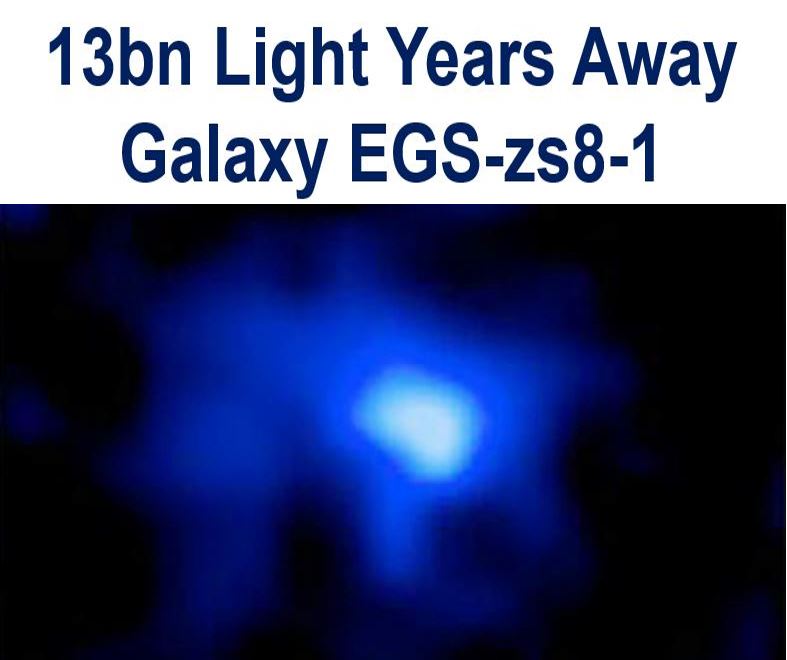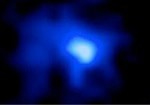Astronomers have unveiled a super distant galaxy, called EGS-zs8-1. It is 13 billion light years from Earth, meaning they have peered into a time when the Universe was just 5% of its present age. The study was carried out by scientists from the US, UK, and the Netherlands.
The exceptionally-luminous galaxy’s exact distance from Earth was determined using the powerful MOSFIRE instrument on the W.M. Keck Observatory’s 10-metre telescope near the summit of Mauna Kea in Hawaii. It is the most distant galaxy ever seen.
EGS-zs8-1, one of the brightest and largest objects in the early Universe, was first identified in images from NASA’s Hubble and Spitzer space telescopes, based on its particular colours.

The light from the EGS-zs8-1 took 13 billion years to get here. (Image: Yale)
For astronomers distance is age
Age and distance go hand-in-hand when talking about the Universe. Light from our own Sun takes eight minutes to get to Earth, while light from very distance stars can take several billion years. So, when we look at them, we are really looking into the Universe’s ancient history.
Lead author of the paper published in Astrophysical Journal Letter, Pascal Oesch, a Yale astronomer, said:
“It has already built more than 15% of the mass of our own Milky Way today. But it had only 670 million years to do so. The universe was still very young then.”
With the new distance measurement, the astronomers were able to determine that EGS-zs8-1 is still forming stars at a rapid rate, about eighty times faster than our Milky Way.
So far, scientists have only managed to calculate the accurate distances of just a handful of galaxies from the early Universe.
Second author, Pieter van Dokkum, the Sol Goldman Family Professor of Astronomy and chair of Yale’s Department of Astronomy, said:
“Every confirmation adds another piece to the puzzle of how the first generations of galaxies formed in the early universe. Only the largest telescopes are powerful enough to reach to these large distances.”
With the MOSFIRE instrument, astronomers can efficiently study many galaxies simultaneously. One of the main goals over the next decade will be to measure galaxies at extreme distances and characterize their properties.
The new observations establish EGS-zs8-1 at a time when the Universe was going through important change – the hydrogen between galaxies was transitioning to an ionized from neutral state.
Co-author, Rychard Bouwens of the Leiden Observatory in the Netherlands, said:
“It appears that the young stars in the early galaxies like EGS-zs8-1 were the main drivers for this transition, called reionization.”
The Spitzer, Hubble and Keck Observatory observations, taken together, pose new questions.
Early galaxies were very different from current ones
While confirming that massive galaxies existed in our early universe, they also show that those galaxies had very different physical properties compared to what we see around us today.
Astrophysicists now have strong evidence that the peculiar colours of very early galaxies – seen in the Spitzer pictures – originate from a rapid formation of massive, young stars, which interacted with the primordial gas and dust in these galaxies.
The observations underscore the exciting discoveries that astronomers hope to make when NASA’s James Webb Space Telescope is launched in 2018, the authors wrote.
The telescope will be able to analyze the galaxy light of EGS-zs8-1 seen with the Spitzer telescope, and provide scientists with more detailed insights into its gas properties.
Co-author Garth Illingworth, of the University of California-Santa Cruz, said:
“Our current observations indicate that it will be very easy to measure accurate distances to these distant galaxies in the future with the James Webb Space Telescope.”
“The result of JWST’s upcoming measurements will provide a much more complete picture of the formation of galaxies at the cosmic dawn.”
Citation: “A Spectroscopic Redshift Measurement for a Luminous Lyman Break Galaxy at z = 7.730 Using Keck/MOSFIRE,” P. A. Oesch, P. G. van Dokkum, G. D. Illingworth, R. J. Bouwens, I. Momcheva, B. Holden, G. W. Roberts-Borsani, R. Smit, M. Franx, I. Labbé, V. González, and D. Magee. Astrophysical Journal Letters. Published 5 May, 2015. DOI: 10.1088/2041-8205/804/2/L30.

